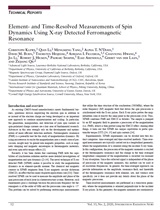
Element- and time-resolved measurements of spin dynamics using x-ray detected ferromagnetic resonance
C. Klewe, Q. Li, M. Yang, A.T. N'Diaye, D.M. Burn, T. Hesjedal, A.I. Figueroa, C. Hwang, J. Li, R.J. Hicken, P. Shafer, G. van der Laan, E. Arenholz and Z. Qiu
Sync. Rad. News 33, 12 (2020)
DOI: 10.1080/08940886.2020.1725796
As existing CMOS-based nanoelectronics meets fundamental barriers, spintronic devices employing the electron spin in addition to or instead of the electron charge are being developed as an important new approach to continue miniaturization and scaling. In particular, the generation, manipulation, and detection of pure spin currents or spin-polarized charge currents are a key area of fundamental research. Advances in this area strongly rely on the development and optimization of more efficient detection methods. Ferromagnetic resonance (FMR) is a powerful tool for the study of magnetization dynamics. By using microwaves to excite the magnetization into a steady state of precession, insight may be gained into magnetic properties, such as magnetic damping and magnetic anisotropies in ferromagnetic materials, and even spin-orbit torque effects.